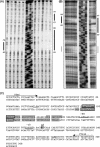Autoregulation of the MisR/MisS two-component signal transduction system in Neisseria meningitidis
- PMID: 16816178
- PMCID: PMC1539957
- DOI: 10.1128/JB.00264-06
Autoregulation of the MisR/MisS two-component signal transduction system in Neisseria meningitidis
Abstract
Two-component regulatory systems are involved in processes important for bacterial pathogenesis. The proposed misR/misS (or phoP/phoQ) system is one of four two-component systems of the obligate human pathogen Neisseria meningitidis. Inactivation of this system results in loss of phosphorylation of the lipooligosaccharide inner core and causes attenuation in a mouse model of meningococcal infection. MisR and the cytoplasmic domain of MisS were purified as His6 and maltose binding protein fusion proteins, respectively. The MisS fusion was shown to be autophosphorylated in the presence of ATP, and the phosphoryl group was subsequently transferred to MisR. The phosphotransfer reaction was halted with a MisR/D52A mutation, while a MisS/H246A mutation prevented autophosphorylation. Specific interaction of phosphorylated MisR (MisR approximately P) and MisR with the misR promoter was demonstrated by gel mobility shift assays, where MisR approximately P exhibited higher affinity than did the nonphosphorylated protein. The transcriptional start site of the misRS operon was mapped, and DNase I protection assays revealed that MisR interacted with a 15-bp region upstream of the transcriptional start site that shared no similarity to binding motifs of other two-component systems. Transcriptional reporter studies suggested that MisR phosphorylation is critical for the autoinduction of the misRS operon. Limited Mg2+ concentration failed to induce expression of the misRS operon, which is the only operon now proven to be under the direct control of the MisRS two-component system. Thus, these results indicate that the meningococcal MisRS system constitutes a functional signal transduction circuit and that both components are critical in the autoregulation of their expression.
Figures








Similar articles
-
MisR/MisS two-component regulon in Neisseria meningitidis.Infect Immun. 2008 Feb;76(2):704-16. doi: 10.1128/IAI.01007-07. Epub 2007 Dec 3. Infect Immun. 2008. PMID: 18056476 Free PMC article.
-
Regulation of the type I protein secretion system by the MisR/MisS two-component system in Neisseria meningitidis.Microbiology (Reading). 2009 May;155(Pt 5):1588-1601. doi: 10.1099/mic.0.023945-0. Epub 2009 Apr 16. Microbiology (Reading). 2009. PMID: 19372150 Free PMC article.
-
Regulatory role of the MisR/S two-component system in hemoglobin utilization in Neisseria meningitidis.Infect Immun. 2010 Mar;78(3):1109-22. doi: 10.1128/IAI.00363-09. Epub 2009 Dec 14. Infect Immun. 2010. PMID: 20008531 Free PMC article.
-
Both MisR (CpxR) and MisS (CpxA) Are Required for Neisseria gonorrhoeae Infection in a Murine Model of Lower Genital Tract Infection.Infect Immun. 2017 Aug 18;85(9):e00307-17. doi: 10.1128/IAI.00307-17. Print 2017 Sep. Infect Immun. 2017. PMID: 28652307 Free PMC article.
-
A two-component system is required for colonization of host cells by meningococcus.Microbiology (Reading). 2009 Jul;155(Pt 7):2288-2295. doi: 10.1099/mic.0.027755-0. Epub 2009 Apr 23. Microbiology (Reading). 2009. PMID: 19389768
Cited by
-
The ChrA response regulator in Corynebacterium diphtheriae controls hemin-regulated gene expression through binding to the hmuO and hrtAB promoter regions.J Bacteriol. 2012 Apr;194(7):1717-29. doi: 10.1128/JB.06801-11. Epub 2012 Jan 27. J Bacteriol. 2012. PMID: 22287525 Free PMC article.
-
Regulation of galactose metabolism through the HisK:GalR two-component system in Thermoanaerobacter tengcongensis.J Bacteriol. 2010 Sep;192(17):4311-6. doi: 10.1128/JB.00402-10. Epub 2010 Jun 25. J Bacteriol. 2010. PMID: 20581213 Free PMC article.
-
MisR/MisS two-component regulon in Neisseria meningitidis.Infect Immun. 2008 Feb;76(2):704-16. doi: 10.1128/IAI.01007-07. Epub 2007 Dec 3. Infect Immun. 2008. PMID: 18056476 Free PMC article.
-
Regulation of the type I protein secretion system by the MisR/MisS two-component system in Neisseria meningitidis.Microbiology (Reading). 2009 May;155(Pt 5):1588-1601. doi: 10.1099/mic.0.023945-0. Epub 2009 Apr 16. Microbiology (Reading). 2009. PMID: 19372150 Free PMC article.
-
Regulatory role of the MisR/S two-component system in hemoglobin utilization in Neisseria meningitidis.Infect Immun. 2010 Mar;78(3):1109-22. doi: 10.1128/IAI.00363-09. Epub 2009 Dec 14. Infect Immun. 2010. PMID: 20008531 Free PMC article.
References
-
- Achtman, M., K. D. James, S. D. Bentley, C. Churcher, S. R. Klee, G. Morelli, D. Basham, D. Brown, T. Chillingworth, R. M. Davies, P. Davis, K. Devlin, T. Feltwell, N. Hamlin, S. Holroyd, K. Jagels, S. Leather, S. Moule, K. Mungall, M. A. Quail, M.-A. Rajandream, K. M. Rutherford, M. Simmonds, J. Skelton, S. Whitehead, B. G. Spratt, B. G. Barrell, and J. Parkhill. 2000. Complete DNA sequence of a serogroup A strain of Neisseria meningitidis Z2491. Nature 404:502-506. - PubMed
-
- Barik, S. 1995. Site-directed mutagenesis by double polymerase chain reaction. Mol. Biotechnol. 3:1-7. - PubMed
-
- Chamnongpol, S., M. Cromie, and E. A. Groisman. 2003. Mg2+ sensing by the Mg2+ sensor PhoQ of Salmonella enterica. J. Mol. Biol. 325:795-807. - PubMed
Publication types
MeSH terms
Substances
Grants and funding
LinkOut - more resources
Full Text Sources

